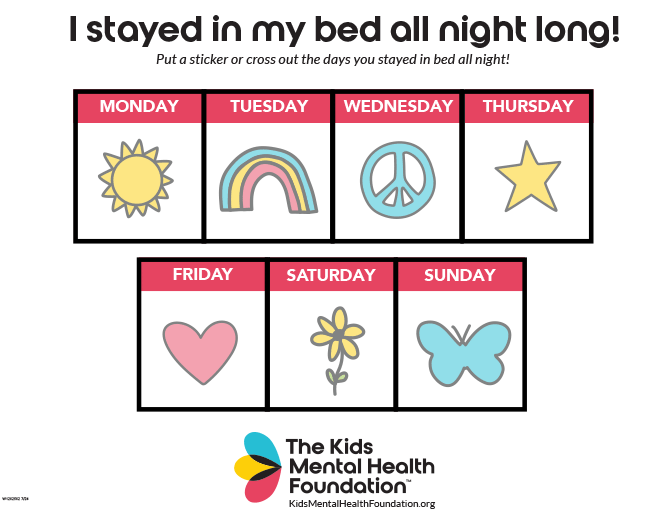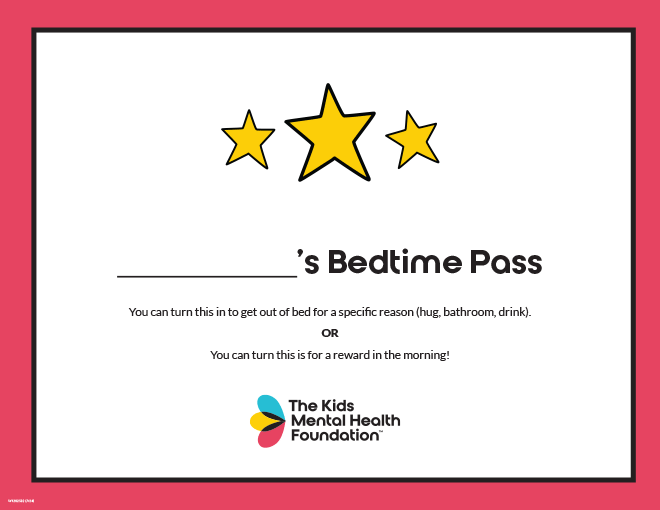Bedtime Battles: Going to and Staying in Bed
Article Summary
- Consistency and patience are key to improving sleep for your child.
- You can help children by establishing nighttime routines and sticking to them as much as possible.
- Try specific strategies, like bedtime passes or a reward chart, which can be download for free below.
Before You Start
- Try to avoid making significant sleep changes before a vacation or when a kid is sick.
- A better time is when you don’t have an important thing to do the next couple of days (If you have a big presentation for work or will be working doubles or switch shift, it might not be the best time to start).
- Consistency is key. It’s better to find a time when you can commit two weeks so you can follow through on the plan rather than stopping and starting multiple times. It’s OK to decide that now isn’t the time to take this on.
- Make sure you have a good reason for making the changes. When you are in the thick of it, this “why” will help you pull through if it gets tough. Remind yourself of the importance of sleep to your child’s overall health.
Where to start?
1.) Routines and sleep habits.
First, make sure you’re practicing good sleep habits. Our brains respond well to schedules and routines. You will not only help decrease behavior battles but help your child’s body start preparing for sleep. For toddlers and pre-school children, having a visual nighttime routine chart with motivating rewards may help.
2.) Good morning light.
Young children don’t know how to read the clock and understand when it’s time for bed. Having visual cues, such as a light that turns on when it’s time to start the bedtime routine, can help decrease bedtime battles. You can buy nightlights that can be set on a schedule or place a regular nightlight on a timer.
If you have a child who wakes up and calls for you in the middle of the night or a child who wakes up too early in the morning, this light is also beneficial. Set the nightlight to stay on during the night and turn it off at a time you’re comfortable with your child getting out of bed. Your child will have a visual cue that lets them know it is still sleep time, everyone in the house is sleeping, and they should return to bed. You can let your child know they can call you for emergencies but otherwise should return to sleep if the light is on.
3.) Bedtime pass.
Using bedtime passes is another good option for children over age 3 who keep “curtain calling” (leaving the room for another hug, to get a drink, to get a snack, to use the bathroom, etc.). Depending on how often your child is leaving their bedroom, you can start with three or four bedtime passes each night. Be sure to explain to your child what the passes are and how to use them:
- They will get so many passes, and they can only get out of bed if they have a pass to use.
- They’ll need to turn in their pass, do their task quickly and go back to bed.
- If they still have passes left in the morning, they will get something special. A sticker chart can be helpful as a reward (see below).
When the child gets up from bed allow them to do what they need to quickly (2-5 minutes), take the pass and send them back to bed. If they are out of passes, send them back to bed with little attention. Download our bedtime pass below for help.
4.) Increase your time away.
Some pre-school aged kids may be used to falling asleep with a parent in the room. If you want to change this, one way to manage this challenge is to say goodnight, leave the room and then pop back in after a short period of time. You could say something like, “I’ll be right back, I forgot to start the laundry. Stay in your bed and try to fall asleep.” Then come right back and give lots of attention and praise for staying in bed and trying to fall asleep. Leave the room again and repeat this until the child is asleep. Gradually increase the time you are away. For example, start by leaving two minutes every night for 3-5 nights. When you’re having success, you can then increase to five minutes for several nights, then eight minutes and so on.
Another option is to gradually remove yourself out of the room. You will start by laying with your child, or holding your child, until they fall asleep for about three nights. Then sit on the bed for another three nights. Then sit next to the bed, then sit further away from the bed, and so on until you are out of the room. Be sure that it is still quiet time and limit time talking or answering questions as much as you can.
Cry it out is another option that may be the hardest to tolerate but it often takes the least time if you can do it. After you tuck your child in and say goodnight, leave the room, and do not come back in unless you are worried about their health or safety. This means ignore all crying, tantrums or fussing. Remember ignoring means no talking, no touching and no eye contact/looking.
How do I reward them for doing well?
Kids love attention and rewards (but let’s be honest, don’t we all?). So when it comes to getting them to get into bed and staying in bed long enough to fall asleep, we need to reward them for good or desired behavior (like staying in bed) and limit attention or ignore undesired behaviors (like leaving their room when they’re supposed to be trying to sleep).
One way to do this is a simple sticker chart. In the morning, you can give a sticker if they stayed in bed the night before or if they did not use all their bedtime passes.
- They can then earn a small reward if they get two stickers in one week.
- Over time, you can make it harder: three stickers in a week, four, etc. You want to start small, so they feel successful and motivated! Download our sample reward chart below.
 Copy Link
Copy Link





